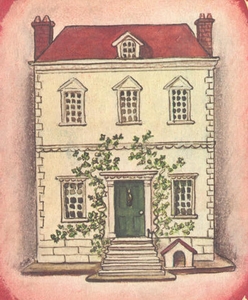
The Doll’s House
Week of January 14, 2008

Chapter Six:
Tottie is discussing the sampler received from Emily’s and Charlotte’s Great Grandmother’s estate. She explained that a sampler is a needlework picture to hang on a wall. It is all worked in cross-stitch on fine canvas, and most times, the stitches are very fine indeed. They are made up with letters and alphabets and a great deal of writing. Little girls would spend many, many hours working on them and learning stitchery.
Charlotte did not like the sampler saying it gave her a headache and she did not understand the poem on it. Emily, however, liked it and would dress Tottie in her first clothes, as old as the sampler, and stand her under the sampler. I believe Emily may have been forming a plan to earn some money for the needed lace and furniture for the dollhouse for she suggested to Charlotte that they stand Tottie beneath the sampler as Mrs. Innisfree was coming to tea. She put a “ticket” under the sampler saying “Example of a real old sampler worked by a little girl in 1846.” Next to Tottie she placed a “ticket” that said “Example of a farthing doll, dressed by that same little girl in 1846.”
Mrs. Innisfree admired Tottie, the sampler and the antique doll house and listened to the story of the doll house and furnishings. She exclaimed that it was a pity about the chairs and couch. Emily told her about the set for sale in Wigmore Street, and when asked if they would purchase it, the girls said “No-o. At least, not yet.” Mrs. Innisfree understood what was happening. She explained to the girls that she is having an exhibition called “Dolls Through the Ages” to help the Blind Children’s Fund and asked the girls if Tottie and the sampler could be in it. Mrs. Innisfree said that they pay for some of the dolls and she should like to pay for Tottie.
Tottie gasped at this turn of events. Charlotte inquired as to how much Mrs. Innisfree would pay – “Would you pay a whole pound?” Mrs. Innisfree offered a guinea, which turned out to be a pound and a shilling.
The Plantaganets couldn’t believe what was happening. Tottie going away!!! Birdie and Apple decided they didn’t want new chairs, but Mr. Plantaganet insisted they needed elegant chairs and this was a good way for Tottie to earn the chairs and perhaps some lace curtains.
Poor Tottie had turned to stone. When Emily picked her up and wrapped
her in white paper to give to Mrs. Innisfree, Tottie lay cold and heavy in her
hand. Emily felt misery and reproach from Tottie but did not understand why.
______________________________
Chapter six was so awful for Tottie! She actually believes she is being sold to buy the furniture for the doll house and her family. She is very brave. I don't really understand why Mr. Plantaganet was willing to let her go, but it might have to do with his background of abuse by the other child. Maybe he hasn't thought it through enough. Birdie is sweet as usual, willing to sit on cotton reels rather than lose Tottie.
I was trying to think how this applies to the Hitty story. She was
a brave doll, but did she ever think she was being sacrificed for the good of
someone else?
______________________________
Tottie had been with the same family all her life, about 100 years.
She is truly devastated when she thinks that they have sold her for the furniture.
Hitty was taken by the Natives on the Island, but she believed she was saving
her peoples lives. To be sacrificed to save ones family is a lot different than
to be sacrificed for some furniture. I really felt bad for Little Tottie.
______________________________
In Hitty's chapters 6 and 7 when she was the idol on the south sea
island, she felt responsible for the lives of the Prebles and the others. Even
though she was treated nicely, she did not like being an idol, and she felt
like she was making a big sacrifice and would have to spend the rest of her
life with the natives. But she would do it gladly to save her family's lives.
______________________________
Tottie felt that she was being given away for good and felt great resentment and sadness towards Emily. To think that Emily would give her away for some lace curtains and some fancy furniture.
Emily on the other hand had the perfect way of earning money for lace
curtains and new furniture for Tottie and the rest of the Plantaganet family.
She never intended to sell Tottie to Mrs. Innisfree for good but, in fact, was
being paid for allowing Tottie to appear at the Exhibition.
______________________________
I really felt bad for poor Tottie in this chapter. Everyone seems so
willing to sacrifice her for some furniture. Mr. Plantaganet might have attachment
disorder because of his prior abuse -- it's the only excuse I can come up with
for him.
______________________________
Yeah--to be sacrificed for a couch and a chair and a curtain is truly
awful. Maybe that's why she felt like she was turning to stone. She must have
felt betrayed.
______________________________
I don't know if all editions of The Dolls' House are the same, but in mine, the illustration for the beginning of Chapter 6 shows the needlework sampler. A close look shows that it is dated 1846. I think Rumer Godden wrote this book in 1946 (it was published in 1947), so we have a similarity between this book and the Hitty book. Just as Rachel Field made her story about the doll whom she guessed to be 100 years old, so did Rumer make Tottie about 100 years old, since she (Tottie) says in Chapter 6 that she remembers Charlotte and Emily's great-grandmother working on the sampler!